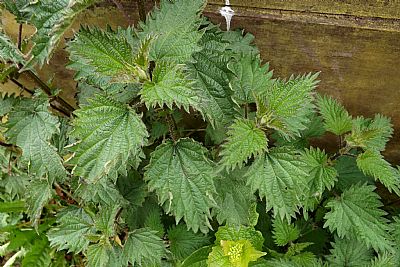NETTLES
Although only one readily comes to mind, there are in fact several types in Scotland : The Common Nettle, the Red Dead Nettle and the Henbit Dead Nettle. Of these it is almost always the common nettle that we come across in West Dunbartonshire and which is very well known for its sting. It is often simply called stinging nettle.
COMMON NETTLE : Urtica dioica
Everyone knows this ubiquitous plant. It looks so innocent yet leads to many a tear.
It has coarsely-serrated leaves. Both leaves and stems are usually covered in hollow stinging hairs, or trichomes, which break easily when touched, injecting several chemicals including formic acid and histamine into humans and animals. This combination of chemicals induces a stinging or burning sensation.
But although it is problematic for us and some animals, consider it a vital food source. Amongst the insects that love nettle are the caterpillars of peacock, small tortoiseshell, red admiral and comma butterflies, aphids and the ladybirds. Some birds such as chaffinches, bullfinches and sparrows also like them as do hedgehogs, shrews, frogs and toads.
It may be hated and feared by many of us, but it also has its good side. It has been used as a medicinal herb since ancient times such as as a laxative and diuretic and to relieve the symptoms of gout and arthritis. The leaves and stems have a high concentration of Vitamin K, along with Vitamins A, C and B2 and with the right preparation can be used as a tea or in soups and salads. Yummy. See index.asp?pageid=731714
NETTLE STINGS
Nettles are covered in tiny hairs each of which has chemicals that get into you much like many little hypodermic needles. The points not only prick your skin, but break off when you brush against them. These chemicals include histamine and formic acid.
If you get stung by nettles, it will not only be painful, but you may come out in white or red spots or red raised patches. There are some good medications availble from your chemist, such as antihistamine, but at the very outset : Gently wash the affected area with soap and water as soon as possible. Avoid scratching or rubbing the itchy area. The discomfort should improve within a couple of hours. Seek medical assistance if it continues. If the casualty is known to be allergic to nettle stings, they may have their own medication, such as an auto-injector. The leaves of the dock plant, which often grows in the same environment, are reputed to help too. This has no technical proof, but is often advised. Perhaps it is merely a placebo effect, but on the other hand the coolness of the leaf, may help. Some advise chewing into a pulp before applied, but dock is actually acidic. Perhaps this works as a counter balance to the sting chemicals. (Dock is toxic for cats and dogs).
Strangely, nettle itself is a valuable antihistamine, but only if properly prepared and can be found at health shops and only for treatment of various allergies.

Fresh nettle appears in mid April.

Nettles in flower in June. Not much to look at from our point of view, but attractive to insects. And of course, insects and other animals feed on the rest of the plant too undeterred by we find painful.

Nettles certainly try to make in quantity what they lack in pretty flowers.

Nettle grows almost anywhere. inadvertently brush against it with your hand and you will have stinging pain for hours. But there are other plants that look suspociously like it. Compare the leaves in the picture below.

Can you see the difference? Nettle above with catmint below. The latter was found in planters in Mitchell Wat, Alexandria, planted by the council. When mature it produces farly tall stalks with small bluish puple flowers. (Catnip has similar leaves, but whitish flowers). Note the leaves with a slightly blue grey colour and more rounded serations. The nettle by contrast has more linear leaf veins and brigher green colour, at least when new. Catmint obviously does not sting. (It in turn looks similar to Lemon Balm).
Incidently, it is catnip that cats enthuse about!
For comparison also see the picture of catmint below. Nepeta genus – catnip is Nepeta cataria and catmint is Nepeta mussinii. Catnip flowers are typically white. Catmint flowers are lavender.

This is an example of catmint planted in planters along Mitchell Way. (Picture 2023).
BETTER HOMES & GARDENS : https://www.bhg.com/gardening/flowers/perennials/catmint-vs-catnip/
GARDENING KNOWHOW : https://www.gardeningknowhow.com/edible/herbs/catnip/are-catnip-and-catmint-the-same.htm
HEALTHLINE : https://www.healthline.com/health/allergies/best-natural-antihistamines#antihistamines
HIGHLAND TITLES : https://www.highlandtitles.com/flower/common-nettle/
PATIENT INFO website : https://patient.info/news-and-features/how-to-soothe-a-stinging-nettle-rash
SCOTTISH WILDLIFE TRUSTS : https://scottishwildlifetrust.org.uk/2019/05/be-nice-to-nettles/
WOODLAND TRUST : https://www.woodlandtrust.org.uk/blog/2019/05/why-do-nettles-sting/

